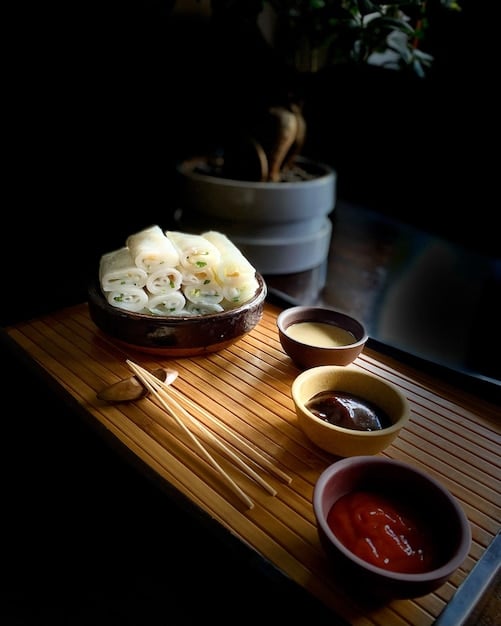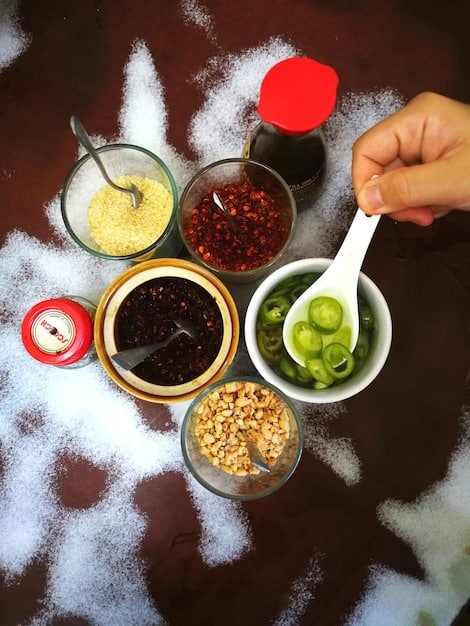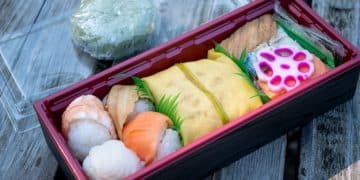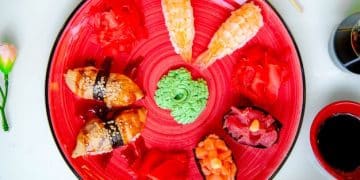Korean Drama Food Cravings: Recreating Iconic Dishes at Home

Korean Drama Food Cravings: Recreating Popular Dishes from Your Favorite Shows at Home delves into the cultural phenomenon of K-dramas influencing culinary desires, offering practical guidance for viewers to authentically
replicate beloved on-screen meals in their own kitchens, ensuring a delicious and immersive experience.
Ever found yourself watching a captivating K-drama, only to be swept away by an irresistible craving for the delicious food featured on screen? From sizzling Korean BBQ to comforting bowls of ramen, Korean Drama Food Cravings: Recreating Popular Dishes from Your Favorite Shows at Home has become a widespread phenomenon, blurring the lines between fiction and culinary reality for fans worldwide. This guide aims to help you bring those tantalizing tastes from your favorite series right into your kitchen.
The Allure of K-Drama Cuisine: More Than Just Food
The appeal of food in Korean dramas extends far beyond simple sustenance; it is intricately woven into the narrative, symbolizing comfort, love, friendship, and even conflict. Viewers often feel a deep connection to these culinary moments, seeing the characters gather around a steaming hot pot or sharing a casual meal in a convenience store. This emotional resonance transforms a simple dish into something much more profound, making the craving for it almost inevitable. The meticulous portrayal of cooking processes, the satisfying sound effects of eating, and the visible enjoyment of the characters all contribute to this powerful gastronomic magnetism.
The portrayal of food in K-dramas is a masterclass in visual storytelling. Directors often use close-up shots of ingredients being prepared, sizzling sounds, and the characters’ expressions of pure delight, making the audience virtually taste the food through the screen. This immersive experience creates a unique connection, blurring the lines between viewer and character. It’s not just about what they eat, but how they eat it – often communally, sharing stories and emotions over a meal. This communal aspect of Korean dining, frequently highlighted in dramas, resonates deeply with audiences who value connection and shared experiences. Moreover, K-dramas often showcase diverse culinary traditions, from elaborate feasts to simple street food, providing a vivid window into Korean culture and daily life. This exposure naturally sparks curiosity and a desire to explore these flavors.
The cultural impact of these series cannot be overstated. K-dramas have become global ambassadors for South Korean culture, and food is a significant component of this diplomacy. As fans immerse themselves in the stories, they also absorb aspects of Korean lifestyle, traditions, and, most prominently, its cuisine. This heightened exposure leads to a genuine desire to experience these dishes firsthand, to participate, even if vicariously, in the cultural phenomenon. The accessibility of many ingredients, along with a plethora of online recipes and tutorials, makes this culinary journey a very achievable one for fans around the globe.
Essential K-Drama Dishes to Recreate at Home
Korean dramas are replete with iconic dishes that consistently make viewers’ mouths water. Many of these are surprisingly simple to prepare at home, requiring basic ingredients often available in Asian markets or even well-stocked local supermarkets. Recreating these dishes offers a tangible way to connect with your favorite shows.
The Ubiquitous Ramyeon
Ramyeon, or instant ramen, is arguably the most common food seen in K-dramas, often enjoyed by characters in casual settings like convenience stores or at home after a long day. It represents comfort and simplicity. While instant ramyeon is quick, elevating it with fresh ingredients like an egg, green onions, and some kimchi can transform it into a more satisfying meal that mirrors the on-screen experience.
- Add a raw egg in the last minute of cooking for a creamy broth.
- Garnish with chopped scallions and a slice of processed cheese.
- Serve with a side of kimchi for an authentic touch.
Tteokbokki: Spicy Rice Cakes
This vibrant red, chewy dish of spicy rice cakes is a street food staple and a frequent feature in K-dramas, often shared among friends or as a quick snack. Its sweet and spicy gochujang-based sauce is incredibly addictive. Making tteokbokki at home allows you to adjust the spice level to your preference.
- Use good quality cylindrical rice cakes (tteok).
- Ensure the gochujang (Korean chili paste) is fresh for optimal flavor.
- Consider adding fish cakes, boiled eggs, or even instant noodles for variety.
Kimchi Jjigae: The Hearty Stew
A warm, bubbling pot of kimchi jjigae is the ultimate comfort food in Korean culture and dramas alike. This hearty stew, made primarily with aged kimchi, pork or tofu, and various vegetables, is perfect for a cozy night in. It’s remarkably forgiving to cook, making it an excellent choice for beginners.
The depth of flavor in kimchi jjigae comes from the fermented kimchi, which creates a rich, tangy, and spicy base. Many variations exist, often incorporating different proteins like tuna or beef, and additional ingredients such as mushrooms or clear noodles. The key is to let it simmer long enough for the flavors to meld. This dish is not just about what’s inside, but the emotional warmth it provides, a recurring theme in K-drama meals. It’s often enjoyed with a bowl of steamed rice, soaking up the flavorful broth.
Jjajangmyeon: Black Bean Noodles
Often seen in dramas as a celebratory dish for graduation or moving day, jjajangmyeon is a savory, earthy noodle dish topped with a thick black bean sauce. Its rich, dark color and umami flavor make it visually distinctive and incredibly satisfying. While it may seem complex, the sauce can be made relatively easily at home.
The preparation of jjajangmyeon typically involves stir-frying meat (usually pork) and vegetables (onions, zucchini) with chunjang (black bean paste), then adding water or broth to create a thick, savory gravy. The noodles are thick, chewy wheat noodles, perfect for coating with the heavy sauce. The cultural significance of jjajangmyeon in K-dramas often ties into new beginnings or a simple pleasure after a hard day’s work. It’s a truly iconic dish that transcends its “delivery food” status for many.
Sourcing Ingredients and Tools for Authentic Flavor
To truly capture the authentic taste of K-drama cuisine, sourcing the right ingredients and having a few essential tools can make a significant difference. While some staple items can be found in most grocery stores, a visit to an Asian market or online specialty stores will unlock a wider array of authentic Korean products.
Key Ingredients to Stock Your Pantry
Building a Korean pantry doesn’t require a massive investment, but focusing on these core ingredients will set you up for success. These foundational items are used in a vast majority of Korean dishes and are crucial for achieving that characteristic Korean flavor profile.
- Gochujang (Korean Chili Paste): A fermented chili paste that provides a savory, sweet, and spicy kick. It’s essential for tteokbokki, bibimbap, and many marinades.
- Gochugaru (Korean Chili Flakes): Used for making kimchi, spicy soups, and stews. It comes in various coarseness levels, from fine powder to coarse flakes.
- Doenjang (Korean Fermented Soybean Paste): A savory, earthy paste similar to Japanese miso but with a stronger, more complex flavor. It’s a staple for stews like doenjang jjigae.
- Soy Sauce: A fundamental seasoning. Korean soy sauces vary; some are lighter for everyday use, while others are darker for richer flavors in stews and braises.
- Sesame Oil: Toasted sesame oil is used as a finishing oil for its distinct nutty aroma and flavor.
- Rice Vinegar and Mirin: For acidity and subtle sweetness in dressings and marinades.
- Korean Noodles: Varieties like ramyeon noodles, glass noodles (dangmyeon for japchae), and fresh wheat noodles for jjajangmyeon.
Essential Kitchen Tools
While you don’t need a professional Korean kitchen, a few specific tools can make your cooking experience more enjoyable and help you achieve better results. These tools are often seen in the background of cooking scenes in K-dramas, playing a subtle but important role in the authentic preparation of meals.

- Dolsot (Stone Pot): Ideal for making bibimbap or jjigae, as it retains heat, keeping food warm and developing a crispy rice layer (nurungji).
- Korean BBQ Grill (portable or stovetop): If you plan on recreating those iconic BBQ scenes from shows like “Weightlifting Fairy Kim Bok-joo,” a tabletop grill is a must.
- Large Wok or Deep Pan: Versatile for stir-frying, simmering stews, and making larger batches of dishes.
- Chopsticks and Spoons: Essential for eating, especially for noodle dishes and soups.
Having these items on hand will not only enhance the authenticity of your K-drama food recreating efforts but also broaden your overall Korean culinary repertoire.
Tips for Achieving Authentic K-Drama Flavors
Replicating the exact flavors from K-dramas can be a rewarding challenge. Beyond just ingredients, there are cooking techniques and presentation tips that contribute significantly to the authenticity and overall experience. Embracing these culinary nuances will elevate your homemade dishes.
Understanding “Son-mat” (Hand Taste)
In Korean cuisine, there’s a concept called “son-mat,” which loosely translates to “hand taste” or “flavor from the hands.” It refers to the unique, often indefinable deliciousness that comes from the cook’s individual touch, experience, and affection put into the food. While you can follow a recipe precisely, developing your own “son-mat” takes practice, intuition, and a willingness to taste and adjust as you go. Many K-drama chefs and characters are often praised for their “son-mat,” highlighting the personal connection to cooking.
The Art of Banchan (Side Dishes)
A Korean meal is rarely just one main dish; it’s almost always accompanied by an array of banchan—small, shareable side dishes. These can range from various types of kimchi to seasoned vegetables, pickled radishes, and more. Including banchan with your main K-drama dish instantly elevates the meal to a more authentic Korean dining experience, as seen in virtually every eating scene.
Presentation Matters: A Feast for the Eyes
Korean food is often as beautiful as it is delicious. Pay attention to how food is presented in K-dramas. Colorful ingredients are often arranged artfully, and dishes are served in specific bowls or platters. Garnishes like toasted sesame seeds, chopped scallions, or a drizzle of sesame oil not only add flavor but also make the dish visually appealing, just like what you see on screen. Think of the vibrant elements of bibimbap perfectly arranged in a bowl.
Mastering Fermentation
Many traditional Korean flavors derive from fermented ingredients. While you don’t need to make your own kimchi or doenjang from scratch, understanding the role of fermentation helps in appreciating and utilizing these ingredients. Aged kimchi, for example, is crucial for a deeply flavored kimchi jjigae. Allowing flavors to meld, especially in stews, by simmering for an extended period, also mimics the depth achieved in traditional Korean cooking.
Beyond the Recipe: Creating a K-Drama Dining Experience
Recreating the physical dishes is only half the journey. To truly immerse yourself in the K-drama food experience, consider setting the scene. The social and atmospheric elements play a crucial role in how food is enjoyed in Korean dramas.
Setting the Ambiance
Think about the typical K-drama dining scene. Often, it involves a cozy, lived-in feel, or perhaps a bustling street food atmosphere. You can replicate this at home by playing K-drama OSTs (Original Soundtracks) in the background, opting for comfortable seating arrangements, or even dining while watching your favorite show. Consider the lighting; softer, warmer lights can create a more intimate and inviting setting, similar to many home-cooked scenes. The goal is to evoke the feeling of being right there with the characters.
Communal Eating: Sharing is Caring
A hallmark of Korean dining, especially popular dishes like Korean BBQ or tteokbokki, is the communal aspect. Dishes are often placed in the center of the table, encouraging everyone to share and interact. If you’re dining with family or friends, serve your recreated K-drama dishes family-style, allowing everyone to take what they wish. This fosters conversation and a sense of togetherness, mirroring the strong bonds often depicted in K-dramas around meal times. Provide plenty of small plates for individual portions and a variety of chopsticks and spoons.
Pairing with Korean Beverages
No K-drama meal is complete without the right beverage. Soju, a clear distilled spirit, is a common accompaniment and features prominently in many drinking scenes. Makgeolli, a milky, lightly carbonated rice wine, is another popular choice. For non-alcoholic options, Korean barley tea (bori-cha), corn silk tea (oksusu-cha), or refreshing fruitades like sikhye (sweet rice punch) can enhance your dining experience and truly complete the immersion into K-drama dining culture. These beverages are often depicted being enjoyed in various social settings, from casual family dinners to celebratory nights out.
Common Challenges and How to Overcome Them
Embarking on a culinary journey to recreate
Korean Drama Food Cravings: Recreating Popular Dishes from Your Favorite Shows at Home
can come with its own set of challenges. However, with a bit of patience and understanding, most of these can be easily overcome, allowing you to enjoy your delicious creations without frustration.
Navigating Ingredient Availability
One of the primary hurdles can be finding specific Korean ingredients, especially if you don’t live near a well-stocked Asian market.
- Online Stores: Many online retailers specialize in Korean ingredients and can ship directly to your door. Websites often carry a wide range of gochujang, gochugaru, Korean noodles, and specialized sauces.
- Ingredient Substitutions: While authenticity is key, sometimes a suitable substitute can work in a pinch. For example, regular chili flakes can partially substitute gochugaru for heat, though the unique flavor profile will differ. Always do your research to find the best alternative.
- Community Resources: Local ethnic grocery stores or even large supermarkets in diverse areas might surprise you with their international aisles. Don’t hesitate to ask store employees for help locating specific items.
Achieving the “Right” Level of Spice
Korean cuisine is known for its bold flavors, often including significant heat. However, everyone’s tolerance for spice varies, and K-dramas, being for a broad audience, don’t always convey the exact spice level.
A common challenge is to achieve the desired level of spiciness without overwhelming the dish or losing its nuanced flavors. Korean chili flakes (gochugaru) and chili paste (gochujang) are integral for heat and flavor. Start with a smaller amount than the recipe suggests, especially if you are sensitive to spice, and gradually add more to taste. For stews, you can often add more chili paste during cooking, allowing it to dissolve and integrate. Remember, it’s easier to add spice than to remove it. You can also offset intense spiciness with a contrasting element like a mild side dish or a cooling beverage like milk or Korean barley tea.
Mastering Cooking Techniques
Some dishes might require specific cooking techniques that are unfamiliar to those new to Korean cuisine.
For instance, achieving the perfect crispy rice at the bottom of a dolsot bibimbap requires precise heat control, while stir-frying japchae (glass noodles) demands quick and efficient movements to prevent sticking. Don’t be discouraged if your first attempt isn’t perfect. Cooking is a skill that improves with practice. Seek out video tutorials for visual guidance, as seeing the technique performed can often clarify steps that are difficult to explain in text. Focus on one or two dishes at a time, perfecting them before moving on to more complex recipes. Practice will build your confidence and refine your “son-mat.”
The Future of K-Drama Food Trends and Your Kitchen
The global popularity of Korean dramas shows no signs of slowing down, and with it, the influence of Korean cuisine continues to grow. As K-dramas evolve, so too will the food trends they introduce, offering an exciting future for home cooks eager to explore new flavors and extend their culinary repertoire.
Emerging Dishes and Culinary Themes
New K-dramas are constantly being released, each with the potential to highlight different aspects of Korean cuisine. This means new dishes, preparation methods, and dining experiences are continually being introduced to a global audience. Watch for specialized regional dishes, lesser-known street foods, or modern interpretations of classic Korean fare featured in upcoming series. As the genre expands into historical dramas, traditional palace cuisine or ancient cooking techniques might also gain renewed interest.
Healthier and Plant-Based Korean Options
As global dietary preferences shift towards healthier and plant-based options, future K-dramas may reflect this, showcasing more vegetarian, vegan, or health-conscious Korean dishes. This could lead to an increased demand for plant-based Korean ingredients and innovative recipes that cater to these preferences, bringing a fresh perspective to K-drama food cravings. Many traditional Korean dishes are already vegetable-heavy, making this transition relatively smooth.
Technological Integration in Home Cooking
The digital age continues to impact how we learn and cook. Expect more interactive online cooking classes led by Korean chefs, augmented reality tools for recipe guidance, or smart kitchen appliances designed to help replicate complex Korean dishes with greater ease. These technological advancements will make it even simpler for fans to recreate authentic K-drama meals at home, bringing the immersive experience full circle. The rise of short-form video content specifically demonstrating minute cooking steps is also likely to continue, simplifying complex processes.
Additionally, as K-pop idols and celebrities often feature in food-related content, their influence could further popularize specific dishes or even novel culinary practices that blend traditional Korean cooking with global influences. This ongoing cultural exchange promises an exciting and perpetually evolving landscape for anyone passionate about Korean culture and its food. The convenience of meal kits specifically designed for K-drama dishes is another area that could see significant growth, simplifying the entire cooking and ingredient sourcing process.
| Key Aspect | Brief Description |
|---|---|
| 🍜 Iconic Dishes | Discover and recreate beloved K-drama foods like Ramyeon, Tteokbokki, and Kimchi Jjigae for authentic flavors. |
| 🛒 Sourcing Essentials | Learn to find crucial ingredients (gochujang, gochugaru) and tools for a genuine Korean cooking experience. |
| ✨ Authentic Experience | Tips for perfect spice levels, delightful banchan, and creating a full K-drama dining ambiance at home. |
| 🔄 Future Trends | Anticipate new K-drama food trends, including healthier options and tech integration in cooking. |
Frequently Asked Questions About Recreating K-Drama Food
▼
Many iconic K-drama foods are quite accessible for home cooking. Dishes like ramyeon (instant noodles with additions), tteokbokki (spicy rice cakes), and simple kimchi jjigae (kimchi stew) are frequently featured and require relatively straightforward steps and common ingredients, making them popular choices for fans to recreate.
▼
Authentic Korean ingredients can typically be found at specialized Asian grocery stores. If there isn’t one nearby, many online retailers offer a wide selection of Korean pantry staples like gochujang, gochugaru, and various types of Korean noodles, delivering them directly to your door.
▼
While a few traditional tools like a dolsot (stone pot) or a Korean BBQ grill can enhance the experience, they are not strictly necessary to start. Most K-drama dishes can be prepared using standard kitchen equipment like a large pot or a wok. Over time, you might consider investing in specialized items.
▼
To control the spice, start by adding smaller amounts of gochujang (chili paste) or gochugaru (chili flakes) than the recipe specifies. You can taste as you go and gradually add more until you reach your desired heat level. For very sensitive palates, consider using less spicy varieties of chili products if available.
▼
For alcoholic options, soju and makgeolli are very popular choices and frequently seen in K-dramas. Non-alcoholic pairings include traditional Korean teas like bori-cha (barley tea) or oksusu-cha (corn silk tea), and refreshing sweet rice punch (sikhye) or various fruit ades, completing the immersive dining experience.
Conclusion
The culinary landscape portrayed in Korean dramas is far more than mere background; it’s a vibrant, integral part of the narrative, deeply inspiring viewers globally to explore Korean cuisine. Korean Drama Food Cravings: Recreating Popular Dishes from Your Favorite Shows at Home proves to be a fulfilling and engaging endeavor, allowing fans to not only satisfy their hunger but also to deepen their connection with the beloved stories and culture. By sourcing authentic ingredients, mastering simple techniques, and embracing the communal spirit of Korean dining, anyone can transform their home kitchen into a delicious extension of their favorite K-drama scenes.





